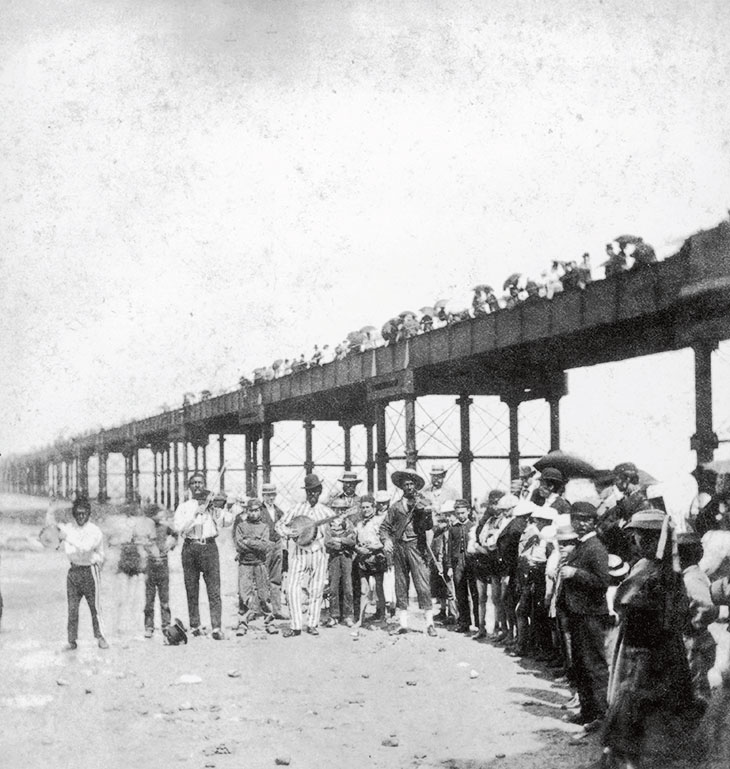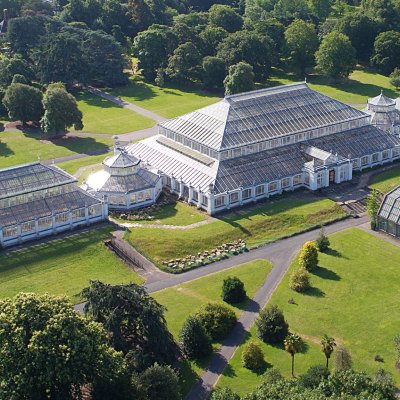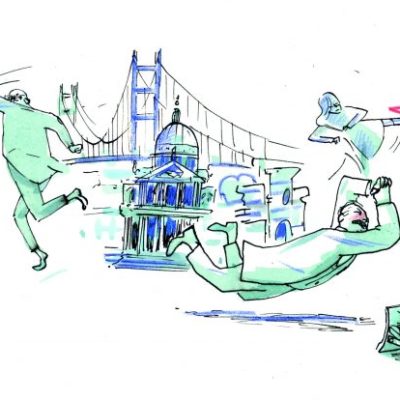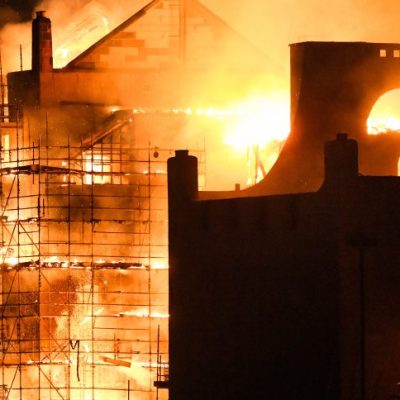Naughty postcards and toffee apples, knees-up songs and double entendres, rollercoasters and gang fights: a trip down the pleasure pier offers up a ragtag bunch of British memories. Gaudy and vulnerable, these spindly old structures are important parts of the island’s cultural memory, artefacts of a form of leisure that seems completely anachronistic in the globalised and electronic age.
But pleasure piers were once a startlingly modern endeavour. Resorts had been developing around the English coast since the 18th century, as at Brighton and Bognor, but the railways rapidly expanded and intensified this leisure industry, bringing millions of people of increasingly varied class to take the air, get near – if not into – the water, and generally escape the fumes of the city. All manner of pleasurable building types and architectural features came with them to the seaside – hotels, theatres, pools, promenades and, of course, piers.
Like so much from the era, the pleasure pier was the result of equal parts entrepreneurial drive, technological innovation, and aesthetic delirium. Recognising conflicts between the demands of the working seafront and the pleasures of tourism, the opportunity was spotted for the creation of artificial promenades that could be used to dock ships and also provide a space for visitors to walk by the sea. The first pleasure pier, at Ryde on the Isle of Wight, was built in 1814 by John Kent of Southampton, and was a 530m-long timber landing-stage with piles sunk into the mud.
The technical opportunity that made the pier boom possible was the same as for the railways and giant sheds so emblematic of 19th-century space – iron. Timber piers were always vulnerable to damage, decay and vermin, so their prospects were limited. An odd transitional type was exemplified by the Chain Pier in Brighton, built by Samuel Brown in 1823. It had four stone piers suspending a deck from iron chains and was reminiscent of Thomas Telford’s work, but it all rested on conventional wooden piles.
A musical troupe entertaining holidaymakers at Margate Pier, Kent, designed by Birch and opened in 1855 (photo: c. 1860) Photo: London Stereoscopic Company/Hulton Archive/Getty Images

The Victorians oversaw the full elaboration of the pier type, a development most associated with the engineer Eugenius Birch (1818–84). The first of his 14 piers was at Margate, replacing a timber pier that had been breached a number of times. Opening in 1855, Birch’s pier made use of iron screw-piles driven into the seabed to increase stability, and an iron superstructure carrying a deck out into the water. Thinner and stronger, yet visually more delicate, this set the standard for the 100 or so piers that would be built in the UK before the end of the 19th century.
Early photographs of pleasure piers show the decks thronged with people dressed in their finest, and indeed one of their primary functions was for promenading. A toll of a few shillings would grant access for a stroll, to see and be seen. But a variety of different uses would follow. Decks and pierheads were widened, allowing for bandstands and, later, theatres to offer musical entertainment. Kiosks and dining spaces also sprang up alongside the docking points that carried people off on pleasure cruises.
Aesthetically, the piers embody the great Victorian tradition of total novelty and wistful nostalgia. The structures themselves range from simply functional braced grids, similar to Paxton’s Crystal Palace, as at Llandudno (1877), to the elegant arches of Clevedon (1869), the century’s knack for ‘fairy-like’ structure beautifully evident. But the pavilions built above the decks engaged in eclectic exercises of varying success, the basic principles set by the Brighton Pavilion’s association of Islamic and Chinese architectural motifs with pleasurable functions. Onion domes and pagodas proliferated, while grand pavilions such as at Great Yarmouth (1902) and Hastings (1872) could fit thousands in their concert halls.
The sight of these odd collections of buildings, wearing historic garb yet appearing effectively to float in the air above the sea is even now thrillingly odd: intensely modern yet endearingly quaint. But the fragility was all too real and from the very early days the piers found themselves in constant peril. Boats had a habit of crashing into them, while storms perennially took their toll. And of course the extensive timber-decking frequently provided fuel for fires, which destroyed many, such as Southsea South Parade (1908), burned during filming for The Who’s Tommy in 1974, or Birch’s Brighton West Pier (1866), which was finally gutted in 2003, having closed in 1975.
The West Pier at Brighton, Sussex, designed by Eugenius Birch (1818–84) and opened in 1866 (photo: 1895). Photo: Paul Brown; courtesy Chroncile/Alamy Stock Photo

Over the years, what had started out as settings for the gentry gradually became part of a working-class holiday culture focused on the seafront, and the ‘improving’ entertainment of classical concerts gave way to variety shows and amusement rides. Pierhead theatres were a vital part of many an entertainment career, from Gracie Fields and George Formby in the early 20th century to Jimi Hendrix and the Rolling Stones in the 1960s, and the likes of Freddie Starr and Russ Abbot still later.
The piers, mainly erected in a fit of buccaneering enthusiasm, often struggled to maintain themselves and despite large crowds bankruptcies were common. The post-war era was especially difficult: many piers had been breached to defend against invasion during the Second World War, and picking up afterwards was costly and difficult. This situation was made worse by the rise in foreign travel, as increasing numbers of ordinary holidaymakers were able to fly off to Spain rather than take the train to Blackpool. Many piers fell into disrepair, the entertainments became ever more louche, and the architectural quality of new pavilions dropped considerably. By the end of the 20th century the piers, like their host towns, were often a melancholy sight.
In later years many piers were passed around between fraudster owners, uninterested conglomerates, and local authorities that couldn’t afford to look after them. But increasingly they were held in clear affection, and when John Betjeman famously said that ‘the Pier is Southend, and Southend is the Pier’, he voiced a nostalgia for a culture that seemed on the verge of vanishing. Since then, local and national campaigns, and the National Piers Society, have fought to save, restore and on occasion sustain the piers. Birch’s Hastings Pier was battered by storms in 1990 and then a fire in 2010. But with lottery money it was restored by a team led by architects dRMM, whose restrained modern work was awarded the RIBA Stirling Prize for Architecture in 2017 (the pier has since been sold to a hotelier for a fraction of the cost of rebuilding, after the Hastings Pier Charity went into administration). While most of the 60 or so piers still left are increasingly vulnerable (even without considering sea level rise), with care and money this odd British institution might have a few more years left in it.
From the October 2018 issue of Apollo. Preview and subscribe here.



